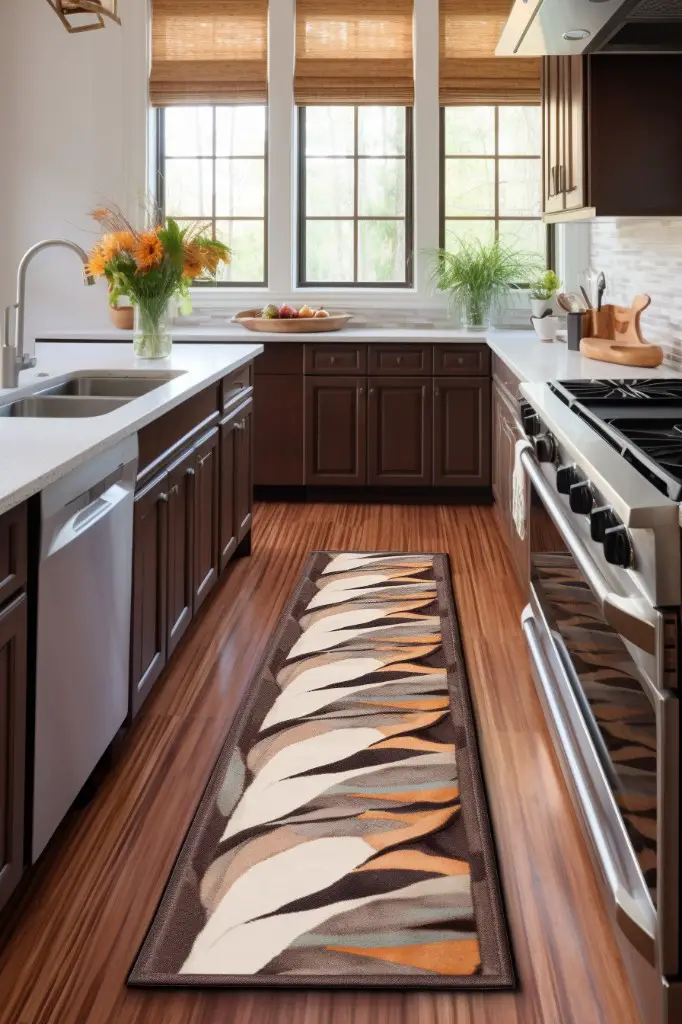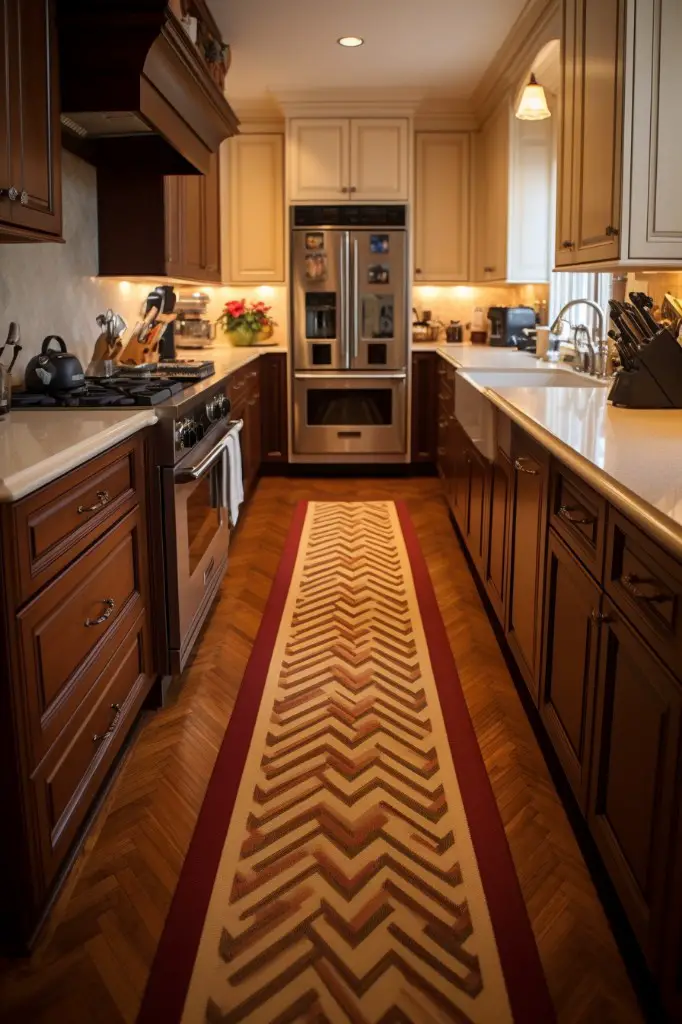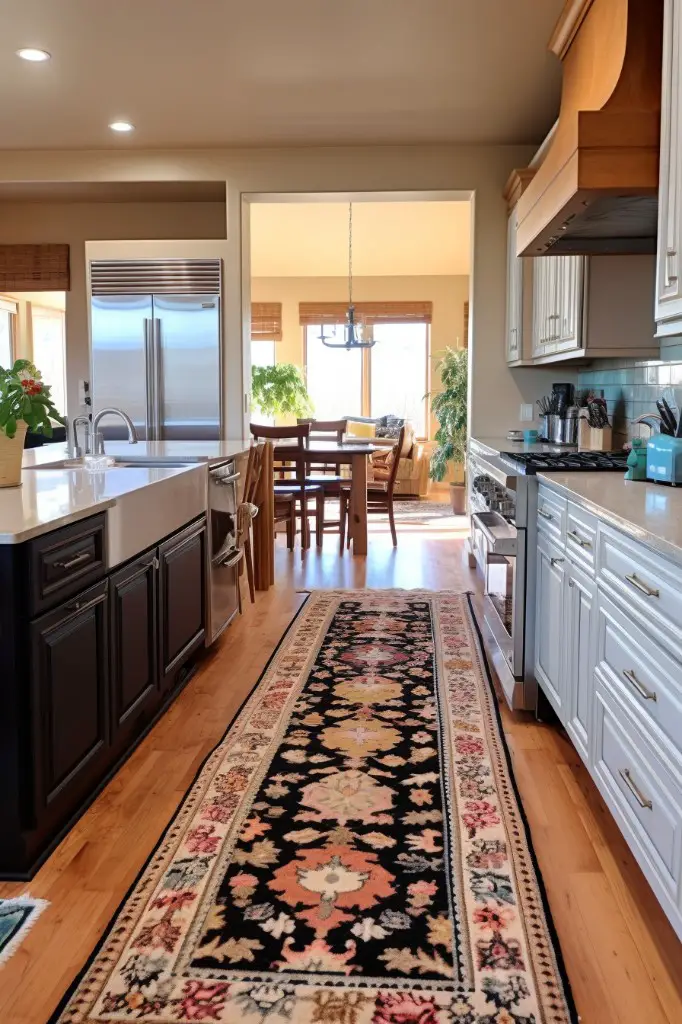Last updated on
Discover the perfect runner size for your kitchen, as we guide you through key considerations and tips to enhance both functionality and aesthetics.
The kitchen is the heart of every home, and it’s essential to make sure that it’s not only functional but also aesthetically pleasing. One way to spruce up your kitchen is by adding a runner rug.
Not only does it add texture and color, but it also protects your floors from spills and scratches. However, finding the right size can be a daunting task.
Should you go for a long or short runner? How wide should it be? Don’t worry; we’ve got you covered! In this article, we’ll guide you through everything you need to know about choosing the perfect size runner for your kitchen. So let’s dive in!
What's Inside
Runner Size Basics

When it comes to choosing the right size runner for your kitchen, there are a few basic rules to follow. First and foremost, you want to make sure that the rug is proportional to your kitchen’s size.
A small runner in a large kitchen will look out of place and vice versa.
Another essential factor is functionality. You don’t want a runner that’s too long or too short as it can create tripping hazards or leave areas unprotected from spills and stains.
Lastly, consider the layout of your kitchen when selecting a rug size. If you have an open-concept design with multiple entry points into the room, you may need more than one rug or opt for larger sizes.
Now you can customizе your runnеr rug that will pеrfеctly fit thе dimеnsions of your kitchеn spacе. Whеn choosing a custom runnеr rug sizе, bе surе to takе prеcisе mеasurеmеnts, taking into account any obstaclеs or furniturе placеmеnt that may affеct thе placеmеnt of thе rug. By invеsting thе timе in this procеss, you’ll ultimately crеatе a cohеsivе and harmonious еnvironmеnt that еnhancеs both thе stylе and functionality of your kitchеn.
Kitchen Layout Considerations

The layout of a kitchen can significantly affect how much floor coverage is needed and where it should be placed. For instance, if you have an open-concept kitchen that flows into other areas like a dining or living room, then you may want to choose a longer runner that covers more ground.
On the other hand, if your kitchen has an L-shaped or U-shaped design with cabinets and appliances on opposite walls, then two shorter runners might work better than one long one. This will help define each area while still providing adequate protection for high traffic zones.
Another important consideration is whether there are any obstacles in the way such as islands or peninsulas. In this case, measure around these features and leave enough space between them and the rug’s edge so that people can move freely without tripping over corners.
Measuring the Kitchen Space

Measuring your kitchen will help ensure that you choose the right size and avoid any potential mistakes. Start by measuring the length of your cabinets or island, depending on where you want to place the runner.
Then add an extra 6-12 inches on each side of your measurement so that there is enough room for chairs or stools if necessary.
Next, measure the width of your kitchen area from one end to another and subtract about six inches from each side so that there is some floor space visible around all sides of the rug.
If placing a rug in front of appliances like stoves or sinks, make sure they are not too close together as this can create tripping hazards when moving between them while cooking or cleaning up after meals.
Standard Runner Widths

Standard runner widths typically range from 2 feet to 3 feet wide. However, some runners can be as narrow as 1 foot or as wide as 4 feet.
The width you choose will depend on several factors such as the layout of your kitchen and how much floor space you want to cover with a rug. If you have a galley-style kitchen with limited floor space, then a narrower runner may be more suitable than a wider one.
On the other hand, if you have an open-plan kitchen that flows into another room or dining area, then opting for a wider rug can help define and separate different areas while adding visual interest.
It’s also worth noting that standard widths may not always fit perfectly in every kitchen space. In this case, custom-made runners are an excellent option since they allow homeowners to tailor their rugs’ dimensions according to their specific needs and preferences.
Standard Runner Lengths
Standard runner lengths vary depending on the manufacturer and style, but most runners come in sizes ranging from 6 feet to 14 feet long.
The length of your runner depends on several factors such as the size of your kitchen and where you plan to place it. For instance, if you have a small galley-style kitchen with limited floor space between cabinets or appliances, a shorter rug may be more appropriate.
On the other hand, if you have an open-concept kitchen with ample floor space or an island that needs coverage underfoot while cooking or prepping meals – then a longer rug would work best.
It’s essential to measure out your intended placement area before purchasing any rugs so that you can get accurate measurements for both width and length requirements. Keep in mind; standard sizes may not always fit perfectly into every nook and cranny of your unique layout.
Choosing the Right Runner Size
The first step in choosing the perfect runner size is to consider your kitchen’s layout and how you use it. If you have a small kitchen, a short runner can make space feel more open while adding color and texture.
On the other hand, if you have a large or open-plan kitchen, longer runners can help define different areas of your space.
Measuring your available floor space accurately is another essential factor when selecting the right rug size for any room in your home. In general, standard widths range from 2-3 feet wide while lengths vary between 6-14 feet long.
When deciding on what length works best for you, consider where exactly in the room will be placing it; this could be by an island or sink area or even underfoot as one cooks at their stove top!
Best Rug Size for a Small Kitchen
A runner that’s too long or wide can make it difficult to move around and may even pose a tripping hazard. On the other hand, one that’s too short might not provide enough coverage for high-traffic areas.
The best rug size for a small kitchen is typically between 2’6″ x 4′ and 3′ x 5′. These sizes are perfect for narrow galley kitchens or compact U-shaped layouts where there isn’t much floor space available.
When selecting your runner, consider placing it in front of high-traffic areas such as the sink or stove area. This will help protect your floors from spills while also providing comfort underfoot when standing for extended periods.
Another tip is to choose lighter colors and patterns as they tend to make spaces appear larger than they actually are. Avoid dark colors or busy patterns that can overwhelm smaller kitchens.
Best Rug Size for a Medium Kitchen
A runner that’s too small will look out of place and won’t provide enough coverage for high-traffic areas. On the other hand, a rug that’s too large can overwhelm your space and create tripping hazards.
So what is the best rug size for a medium kitchen? The answer depends on your specific layout and needs. As a general rule of thumb, you’ll want to choose a runner that measures between 2’6″ x 8’0″ or 3’0″ x 5’0″.
These sizes are perfect for providing ample coverage without overwhelming your space.
If you have an open-concept kitchen with an island or peninsula, consider using two runners instead of one long one. This approach not only adds visual interest but also helps define different zones in your kitchen.
Best Rug Size for a Large Kitchen
A larger rug will also provide more coverage and protection for your floors. When choosing the best rug size for a large kitchen, consider the layout of your space and how much floor area needs covering.
For an open-concept kitchen or one with an island, opt for a longer runner that spans the length of both areas. This creates continuity and helps define separate zones within the room.
If you have ample floor space between cabinets or appliances, go bold with wider runners to add visual interest without overwhelming other design elements in your kitchen.
When it comes to selecting colors and patterns for larger kitchens, keep things balanced by choosing rugs that complement rather than compete against existing decor elements like backsplashes or countertops. Neutral tones work well as they blend seamlessly into any color scheme while adding texture through subtle patterns like stripes or geometric shapes.
Rug Size for Kitchen Island
You want to make sure that the rug is not too small or too big for your island. A good rule of thumb is to choose a runner that’s slightly longer than your island and wide enough so that you can comfortably walk around it.
If you have a large kitchen with an oversized island, consider using two runners instead of one long one. This will create symmetry and balance in the space while also protecting your floors from scratches caused by chairs being pulled in and out.
Another option is to use multiple smaller rugs placed strategically around the perimeter of your island. This approach works well if you have an open-concept kitchen where there are no clear boundaries between different areas.
Ultimately, choosing the right runner size for your kitchen island depends on several factors such as layout, personal preference, and budget constraints.
Kitchen Rug Size for Stove Area
The stove area is one of the busiest spots in any kitchen, and having a rug that fits perfectly can make all the difference. A well-fitted rug not only adds style but also protects your floors from spills and stains.
To determine what size runner you need for your stove area, measure the length of your stove plus an additional 2-3 feet on either side. This will ensure that there’s enough space around it for easy movement while cooking or cleaning up.
For a small kitchen with limited space around its stove area, opt for a narrow runner measuring about 2 feet wide by 6-8 feet long. This will provide ample coverage without overwhelming or cluttering up this part of your kitchen.
In contrast, if you have more room to work with in a larger-sized kitchen or open floor plan layout where multiple people may be working at once near this spot – go bigger! Consider using runners that are wider than usual (upwards of three-feet) so they can accommodate more foot traffic comfortably while still providing adequate protection against spills and scratches on flooring surfaces beneath them.
Kitchen Rug Size for Sink Area
A runner that’s too small will not only look awkward but also won’t provide enough coverage for spills and splashes. On the other hand, a rug that’s too big can be cumbersome and pose tripping hazards.
To determine the right size for your sink area, measure from where you want your runner to start (usually at least 6 inches away from cabinets or appliances) to where you want it to end (typically just before any doorways). Make sure you leave enough space on either side of your sink so that there is no risk of slipping when stepping onto or off of the rug.
For smaller kitchens with limited counter space around their sinks, consider using a circular or oval-shaped rug instead. These shapes can add visual interest while still providing ample coverage without taking up valuable floor real estate.
Ultimately, choosing an appropriately sized kitchen runner for your sink area comes down to personal preference as well as practicality.
Material Options for Kitchen Runners
The most popular materials include cotton, wool, synthetic fibers like nylon and polyester, and natural fibers such as jute or sisal.
Cotton runners are a great option if you’re looking for something soft and comfortable underfoot. They’re also easy to clean and maintain.
Wool runners offer durability while still being soft underfoot. They come in a variety of patterns that can add texture to your kitchen decor.
Synthetic fiber runners like nylon or polyester are durable options that resist stains well. These types of rugs work well in high-traffic areas where spills may occur frequently.
Natural fiber runners such as jute or sisal provide an eco-friendly option with their biodegradable properties. However, they may not be the best choice if you have pets since they tend to attract pet hair easily.
Benefits of Kitchen Runners
One of the most significant advantages is that they protect your floors from scratches, spills, and stains. Kitchen floors are prone to wear and tear due to high traffic, making them susceptible to damage over time.
A runner rug acts as a barrier between the floor and foot traffic while adding an extra layer of protection against spills.
Another benefit of using kitchen runners is that they provide comfort underfoot when standing for long periods while cooking or washing dishes. The cushioning effect helps reduce fatigue on feet, legs, and back muscles.
In addition to their functional benefits, kitchen runners can also enhance the overall look of your space by adding color or texture that complements other decor elements in the room.
Non-slip Features
The last thing you want is to slip and fall while carrying hot food or sharp objects. That’s why non-slip features are essential in any kitchen runner.
Most runners come with some form of backing that helps keep them in place, but not all backings are created equal. Look for runners with rubber or latex backing as they provide the best grip on smooth surfaces like tile or hardwood floors.
Another option is to use rug pads underneath your runner rug. Rug pads not only prevent slipping but also add extra cushioning and extend the life of your rug by preventing wear and tear from friction against hard flooring surfaces.
In addition to providing safety benefits, non-slip features can also enhance the durability of your kitchen runner over time by reducing movement caused by foot traffic and cleaning activities such as vacuuming or sweeping.
Popular Runner Styles
The most popular styles include traditional, modern, and farmhouse. Traditional runners feature intricate patterns and designs that add elegance to any kitchen space.
Modern runners have clean lines and geometric shapes that give a contemporary feel to the room. Farmhouse-style runners are perfect for those who want a cozy yet stylish look in their kitchens.
Another popular trend is using vintage or antique rugs as kitchen runners. These unique pieces can add character and charm while also being functional in high-traffic areas like the kitchen.
No matter what style you choose, make sure it complements your existing decor while also adding personality to the space.
Runner Maintenance and Care
Proper maintenance will not only keep your rug looking new but also extend its lifespan. Here are some tips on how to maintain and care for your kitchen runner:
1. Vacuum regularly: Dirt and debris can accumulate in the fibers of a rug over time, causing discoloration or damage if left unattended.
Regular vacuuming helps remove dirt particles from deep within the fibers.
2. Spot clean spills immediately: Accidents happen in every household, so be prepared to tackle them as soon as they occur by spot cleaning any spills right away with a damp cloth or paper towel.
3. Rotate periodically: To ensure even wear and tear on your runner, rotate it periodically so that one area doesn’t get more foot traffic than another.
4. Professional cleaning: For tough stains or deep cleaning needs, consider hiring a professional cleaner who specializes in rugs.
DIY Kitchen Runner Ideas
You can customize the size, color, pattern, and material according to your preferences. One of the easiest ways is by repurposing old clothes or fabrics that you no longer use.
Cut them into strips or squares and sew them together in a patchwork style for a bohemian look. Alternatively, if you have basic sewing skills, consider creating a braided rug using fabric scraps or even old t-shirts! Another option is stenciling designs onto plain canvas rugs with fabric paint for an artistic flair that matches your decor theme perfectly.
DIY projects are always fun as they allow us to unleash our creativity while also saving money on expensive store-bought items. So go ahead; give it a try!
Budget-friendly Runner Options
You can find runners made from synthetic materials like nylon or polyester that mimic the look and feel of natural fibers such as wool or cotton. These materials are not only durable but also easy to clean, making them perfect for high-traffic areas like the kitchen.
Another budget-friendly option is to repurpose an old rug by cutting it down to size and adding a non-slip backing. This DIY approach allows you to customize your runner’s size and style while saving money.
You can also consider purchasing runners during sales events or clearance sales at home decor stores. Keep an eye out for discounts on discontinued styles or seasonal items that may be marked down significantly.
Best Kitchen Runner Brands
Not only do they offer quality products, but they also provide excellent customer service and warranties. Here are some of our top picks for kitchen runner brands:
1. Safavieh: Known for their stylish and durable rugs, Safavieh offers a wide range of options that cater to different styles and budgets.
2. Mohawk Home: With over 125 years in the industry, Mohawk Home is a trusted brand that produces high-quality runners with non-slip features.
3. Maples Rugs: This family-owned business has been producing affordable yet stylish rugs since 1928.
4. Ottomanson: Offering both traditional and modern designs at an affordable price point, Ottomanson’s runners are perfect for those on a budget.
5. Nourison Industries: If you’re looking for luxury runners with intricate designs or patterns made from premium materials such as wool or silk blends – Nourison Industries is your go-to choice!
Remember that while these brands have proven themselves in terms of quality products; always consider your personal preferences when making any purchase decision!
FAQ
How do I choose a kitchen runner length?
To choose a kitchen runner length, select the longest size possible without it sitting flush with the wall to avoid making the space feel cramped and small.
What size runner should I get?
You should get a runner measuring between 2-3 feet wide and 6-14 feet long, matching the shape of the hallway and not extending into other rooms.
What size rug is best in front of kitchen sink?
The ideal size of a rug in front of a kitchen sink is a 3×5 area rug, as it provides a comfortable space to stand without occupying too much room.
Should you put a runner in your kitchen?
Yes, you should put a runner in your kitchen, as they are perfect for narrow spaces, make smaller kitchens appear more spacious, and can be substituted with comfort mats or area rugs if needed.
What factors should be considered when selecting a kitchen runner material?
When selecting a kitchen runner material, consider factors like durability, stain resistance, moisture absorption, and ease of cleaning.
How can I determine the appropriate runner width for my kitchen space?
To determine the appropriate runner width for your kitchen space, measure the width of the walkway or area where you’d like to place the runner and subtract 4-6 inches to allow a few inches of exposed floor on each side.
Are there specific styles or patterns that work better for kitchen runners?
In kitchen runners, specific styles or patterns that work better include easy-to-clean, slip-resistant, and water-absorbent designs.




